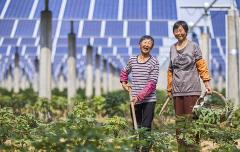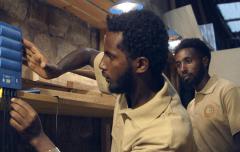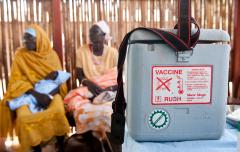Five takeaways from the Africa Energy Outlook 2019
We are entering the final decade to achieve the Sustainable Development Goals (SDGs), including SDG7—affordable, reliable, sustainable and modern energy for all by 2030.
Africa’s energy future can make or break SDG7. The continent is home to almost 600 million people who currently have no electricity access and 900 million without clean cooking options, according to 2019 Tracking SDG7: The Energy Progress Report.
Last week the International Energy Agency (IEA) released the Africa Energy Outlook 2019, described as its “most comprehensive and detailed work to date on energy across the African continent, with a particular emphasis on sub-Saharan Africa.” The report is a welcome complement to the 2019 Tracking SDG7 report; it provides detailed energy profiles for 11 African countries and elaborates on several important trends shaping Africa’s energy future.
For example, the report indicates that urbanization in Sub-Saharan Africa is happening at an unprecedented speed and scale—expected to be twice as large as the projected growth of the urban population in India over the next two decades. This will drive up energy demand for industrial production, cooling and mobility.
Africa’s young, rapidly growing population adds further pressure to energy systems already struggling to provide access to significant portions of the population. Yet, Africa is gifted with a bounty of energy resources, including solar, wind and hydro, that will be vital to delivering new energy access that will fuel people’s well-being and economic opportunities.
In the face of these trends, it is imperative that African governments and their development partners put in place policies and investments that are commensurate with the continent’s massive and urgent energy needs. The Africa Energy Outlook 2019 provides valuable insights into what needs to happen across the continent, and beyond, to build sustainable, inclusive and efficient energy systems in Africa.
Here are five key takeaways from the report identified by Sustainable Energy for All (SEforALL) that should be kept in mind to provide a sharper focus on the remaining challenges and priorities.
1. Progress on clean cooking is lacking…a rethink is needed
The IEA report offers further proof that current efforts to deliver clean cooking access are woefully inadequate and ineffective. Consistent with 2019 Tracking SDG7 report, IEA projects that in 2030, based on existing stated policies, the number of people without clean cooking access across Africa is expected to grow to just under 1 billion.
The fact that we are regressing on this issue is due to a clear lack of political will and investment in the sector. This year’s Energizing Finance findings found that a cumulative USD 32 million was invested in the clean cooking sector across 20 high-impact countries in 2017, yet the scale of the problem demands approximately USD 4 billion in investment globally.
The report also underscores the importance of transitioning away from traditional solid biomass for cooking to more efficient and modern fuels. According to the IEA report, fuels such as biogas and LPG are promising solutions that could enable this transition. Their promise lies in the continent’s abundance of agricultural waste and increasing gas discoveries. But as pointed out by the IEA, realizing the potential of such fuels is dependent on making them more affordable and improving Africa’s fuel infrastructure.
2. Examples to follow on electrification
Under current and planned policies, Africa will fall well short of universal electrification and will be home to 9 out of 10 people living without electricity.
This is a plea to African governments and their partners to focus greater effort and resources on electricity access. These efforts can be guided by existing success stories across the continent. The IEA report recognizes several African countries that are on track for universal access to electricity, including Kenya, Ethiopia, Ghana, Senegal and Rwanda.
What the report does not recognize as well is the growing use and importance of Integrated Electrification Pathways for scaling up electricity access since grid densification and expansion alone will not reach the goal of universal access. Decentralized solutions are essential for providing access to millions of people in hard-to-reach, rural areas, creating a major opportunity for the renewable energy sector.
Countries that have embraced an integrated approach are harnessing high-level political support, collaborative planning and various technologies—grid, mini-grid and off-grid—to bring new electricity access to millions. But these countries may not be alone for much longer. Ministers from 39 African countries adopted a recommendation presented by SEforALL on integrated electrification as part of the African Union Commission's Cairo Declaration.
3. Don’t overlook reliable electricity, especially for productive uses
Providing residential electricity to the millions of Africans currently without access is essential for ensuring human development. But electrification strategies need to also address the reliability and quality of electricity supply and their role in enabling economic activity.
Africa Energy Outlook 2019 rightly points out that residential demand will be only a small fraction of anticipated electricity demand on the continent. Growing urban populations mean rapid growth in energy demand for agriculture, industrial production and infrastructure.
Economic development hinges on reliable electricity supply for businesses, schools, hospitals, mobility solutions, and more. Here, IEA’s analysis could benefit from use of the World Bank’s Multi-Tier Framework (MTF), a methodology that measures multiple attributes of electricity supply, to provide decision makers with a fuller and more nuanced picture of electricity access. The MTF has been increasingly used by partners around the world.
Africa can pursue a much less carbon-intensive model of development than seen elsewhere in the world thanks to its huge renewable energy and gas potential. Such a low-carbon future will rely on a commitment to energy efficiency to manage overall energy demand.
4. Growing need for efficient, sustainable cooling
Another important use for electricity identified in the IEA report is cooling. Africa Energy Outlook 2019 reinforces our recent Chilling Prospects: Tracking Sustainable Cooling for All 2019 report, which finds that Africa is particularly vulnerable to a lack of cooling access.
As temperatures rise and populations grow across Africa, so does the need for establishing cold chains to make sure that food and medicines are protected from heat. People need protection too: the IEA forecasts that, under current policies, residential cooling demand will more than quadruple by 2040.
Of course, sustainable cooling solutions must be developed with a strict focus on efficiency to ensure they are in line with available supplies of electricity. In fact, many solutions may not even require a power supply, such as cool roofs. Understanding precise cooling needs and how these match with potential solutions is a measure highlighted in our Cooling for All Needs Assessment.
5. Innovative finance for energy access
The need for financial innovation is a common theme across all the above takeaways. Finance is the lynchpin for achieving SDG7, in Africa and beyond.
Like our Energizing Finance work, the IEA report highlights massive shortfalls in finance for electricity and clean cooking across Africa. The IEA states that reaching full electricity access by 2030 in Sub-Saharan Africa would require over USD 100 billion per year in investment, a five-fold increase from today’s levels of investment. Yet Energizing Finance 2019 shows that in several Sub-Saharan African countries investment in electricity access is declining.
One area for innovation, and a key problem noted by the IEA and SEforALL, is that public investment in electricity in Africa is not catalyzing private capital as well as it could. Addressing perceived risks by the private sector can be done through concessional capital. Governments, development financial institutions and philanthropies can work with private financiers to create new blended finance structures that support energy sector enterprises.
These are just a handful of insights found in Africa Energy Outlook 2019. This report provides further data and evidence for Africa’s importance to the achievement of SDG7, and it shows where progress is needed and where opportunities lie for delivering sustainable energy access across the continent.
We look forward to exploring these insights further and to welcoming IEA, and partners from around the world, at the next SEforALL Forum in Kigali, Rwanda.




